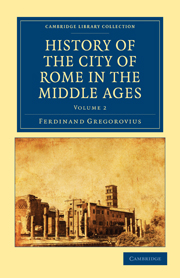Book contents
CHAPTER V
Published online by Cambridge University Press: 05 July 2011
Summary
More praiseworthy than his ceaseless striving to increase the newly-arisen ecclesiastical State were Adrian's efforts for the welfare of the Roman people. He was the restorer and rebuilder of the city, the increased revenues at the disposal of the Church, and the peace which the country enjoyed, providing him with the means of carrying out his schemes of benevolence.
The city was old and decayed; the churches, the walls, the aqueducts, the banks of the river, were in need of a thorough restoration. In December 791, Rome was again devastated by an inundation of the Tiber. The waters tore down the Flaminian Gate, carrying its ruins to an arch in the Via Lata, known as Tres Falciclas. They further destroyed the ancient Porticus Pallacinse near S. Marco, and threatened the bridge of Antoninus, now called the Ponte Sisto. Neither the ancient Emperors nor the Popes had been able to impose a check upon the Tiber, and nothing being any longer done to cleanse its channel or dam up its banks, its waters continued from time to time to lay waste the city.
Adrian restores the walls
Adrian had apparently restored the walls and towers of Rome previous to the year 791. Although this work of restoration had been begun under Gregory the Third, it had either not been sufficiently complete, or else the last siege under Astolf had seriously injured the walls.
- Type
- Chapter
- Information
- History of the City of Rome in the Middle Ages , pp. 383 - 417Publisher: Cambridge University PressPrint publication year: 2010First published in: 1894



